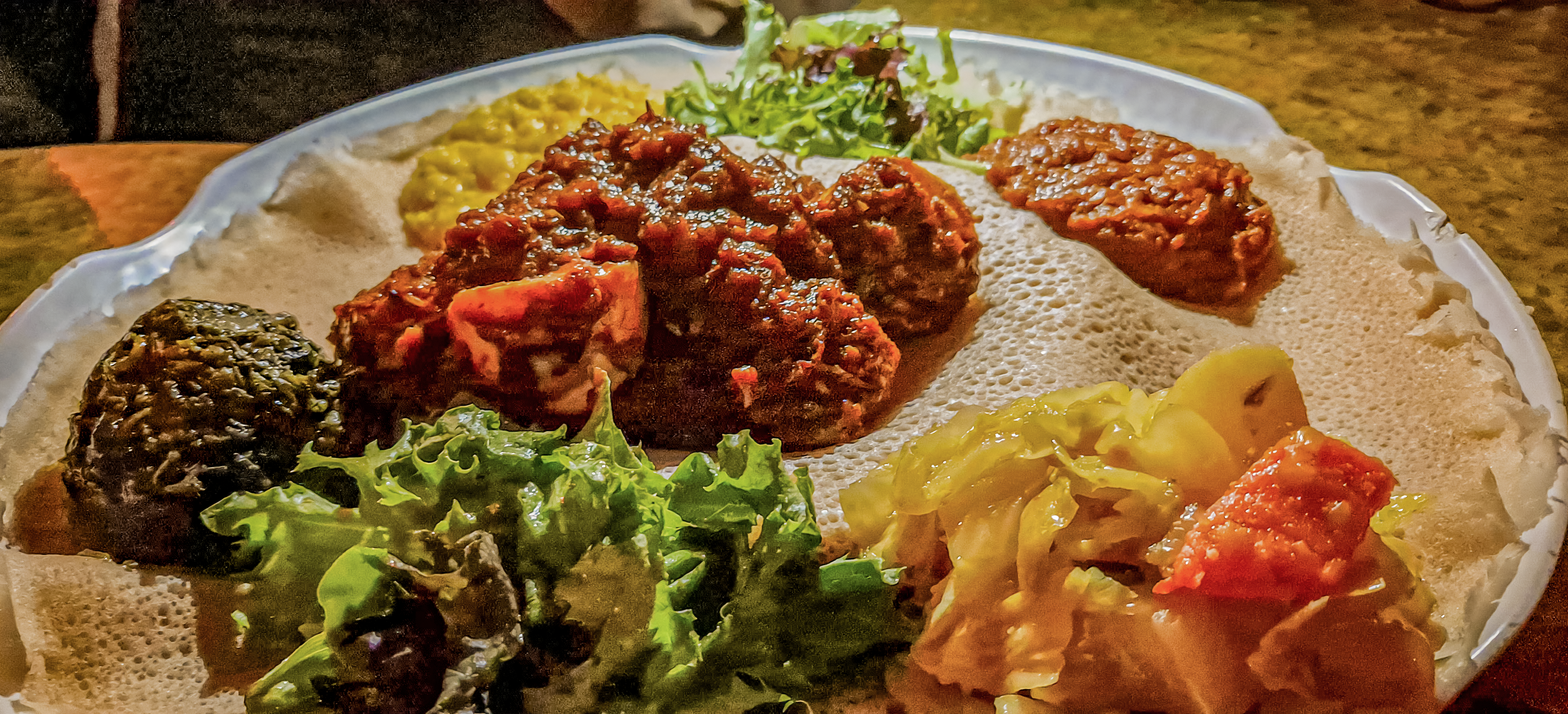If ever there was a time for celebrating the depth and riches of Ethiopian culture, and Ethiopian food in particular, the holiday of Sigd is it. Most American Jews are still learning about the holiday but it has been on the Israeli calendar for over a decade and the Ethiopian Jewish calendar for centuries.
Sigd is a celebration of community and the traditions that kept the Ethiopian Jewish community strong through years of persecution. Today it is marked by prayer and by festive meals, music, and dance. Throughout Israel, Ethiopians mark Sigd by bringing the unique elements of our culture to share with other Jews.
Even if there is no Sigd festival in your synagogue or community in the United States, it is a great opportunity to try out Ethiopian food at home. In 2021, Sigd falls on Wednesday, November 3rd-Thursday, November 4th. Ethiopian food is unique and consists of a variety of dishes. Different tribes eat different types of food.
The most common dish in Ethiopia is served with injera which is a fluffy flatbread. Injera is made of a superfood grain called teff which is gluten-free and a great source of iron. Injera is typically served with meat or vegetable stew which is also called wat in Amharic, one of the main languages of Ethiopia. Wat means stew -vegetarian or meat-based. Most Wat dishes are cooked with multiple spices which are not surprising given the country’s involvement with the spice trade since ancient times.
Whether meat or vegetarian, wat begins with a large amount of chopped red onion, which is simmered or sauteed in a pot. Once the onions have softened, Oil is added. The key to a successful wat lies in the spices. Ethiopians have many spice blends that are unique to our country. For example, if you want a red wat, one adds, berbere which is a spice blend that creates the base for a spicy keiy wat ( red stew). Berbere is used similar to that of red curry or yellow curry in Indian cooking. If you want a yellow stew or an achila wat then you use tumeric as the main spice. The dish is finished by the addition of meat such as beef, chicken ,fish, goat or lamb. Legumes such as split peas and lentils or vegetables such as potatoes, carrots and chard are also used instead in vegan dishes.
The final name of the dish will tell you what is in it. Each variation is named by appending the main ingredient to the type of wat (e.g. kek alicha wat –spicy pea wat). However, the word keiy is usually not necessary, as the spicy variety is assumed when it is omitted (e.g. doro wat). Generally speaking, red wat is the main dish while the yellow dishes are considered variations on the main them, which is a reminder of how important Berbere spice is in Ethiopian food.
Doro Wat – Ethiopian Chicken Stew
Traditionally, when making Doro wat, a whole chicken is used. The chicken is washed in lemon juice, vinegar solution, and with salt and the chicken is cut into twelve pieces, representing the twelve tribes of Jacob in the bible.
In Ethiopia, every family has their Doro wat recipe, and just like most traditional dishes, they really don’t measure their ingredients. That is why it’s hard to find two exact recipes for Doro wat. In other words, they use their instincts, and the result is outstanding! In this recipe, we are just taking 4 chicken thighs, not the whole chicken.
Ethiopian food has a lot in common with food from South India, especially when it comes to spice blends. Berbere spice is the Ethiopian equivalent of India’s garam masala and is used to flavor various dishes including the national dish of Ethiopia called doro wat. No spice blend is as essential to Ethiopian cuisine as berbere spice.
There is also no one berbere spice blend since cooks typically make their own and switch out ingredients according to personal taste. Most blends do have a heavy chili pepper component as well as strong aromas from spices like cinnamon and cardamom along with savory notes from cumin and black peppercorns. They also tend to include fenugreek and ginger. The result is always a complex set of sweet flavors with citrus notes, mild bitterness, and moderate to high levels of heat.
For those of you who have difficulty locating berbere in your local grocery store, you can easily make substitutes at home. Note that it is quite spicy. This spice combination is used in many Ethiopian dishes including doro wat, the Ethiopian chicken dish the recipe for which can be found below.
Ingredients:
- ¼ cup lemon juice
- ¼ cup vinegar
- 2 tablespoons salt, plus more as needed
- 4 bone-in chicken thighs
- 6 cups chopped red onions
- 2 tablespoons vegetable oil
- 4 teaspoons of minced garlic
- 1 tablespoon peeled, minced fresh ginger (1/2-inch piece)
- water (optional)
- 1 cup berbere spice (either purchased or homemade from this list)
- ½- 1 cup red chili powder (this can be adjusted to taste)
- ½ cup paprika
- 1 tablespoon salt
- 1 teaspoon ground fenugreek
- 1 teaspoon ground ginger
- 1 teaspoon onion powder
- 1 teaspoon ground coriander
- 1 teaspoon ground cardamom
- ½ teaspoon garlic powder
- ¼ teaspoon ground cloves
- ¼ teaspoon ground cinnamon
- ¼ teaspoon ground nutmeg
- Additional mixed spices
-
- ½ teaspoon ground coriander,
- 1 teaspoon ground cardamom,
- ¼ teaspoon dried thyme
- freshly ground black peppercorns
- 4 hard-boiled eggs, peeled
- Injera bread (Ethiopian bread) or hot cooked rice, to serve
DIRECTIONS :
- Clean the chicken very well. Mix the lemon juice, vinegar, and salt. Add the chicken to the mix. Rinse and drain when ready to use.
- Mince, red onions, garlic, and ginger.
- Add the finely minced onions (you can use a food processor if available) to a pot over low to medium heat. The onions will sweat and create the water they will simmer in. if your onions are not sweating, add water.
- Continue to stir the onions to prevent burning until they change color (light pink color). About 30 to 40 minutes. When they are done, the water will evaporate, and the onions will begin to stick to the bottom of the pot.
- Stir in 2 tablespoons of vegetable oil.
- Add minced garlic, and ginger
- Add your berbere spice. [If you did not purchase berbere spice, mix together chili powder (this can be adjusted to taste), paprika, salt, ground fenugreek, ground ginger, onion powder, ground coriander, ground cardamom, garlic powder, ground cloves, ground cinnamon, ground nutmeg in a bowl. This is your Berbere Spice mix.]
- Add your additional Ethiopian spices: ground coriander, ground cardamom, dried thyme, and ground black peppercorns (to taste). Stir well. You will have a thick sauce.
- Remove the chicken from the lemon juice and discard the marinade. Add the chicken to the pot and cover with sauce. If the sauce does not cover the chicken add a little water until it does.
- Bring the sauce to a boil, reduce the heat to low, cover and simmer for 45 minutes, flipping the chicken halfway through. Add water, if necessary, to maintain the liquid level.
- Add the whole hard-boiled eggs.
- Serve either with injera or poured over rice.
THE REST IS NOTES
Other cuisines:
The cuisines of the Southern Nations, Nationalities and People’s Region and the Sidama region also make use of the false banana plant (enset, Ge’ez: እንሰት ïnset), a type of ensete. The plant is pulverized and fermented to make various foods, including a bread-like food called kocho (Ge’ez: ቆጮ ḳōč̣ō), which is eaten with kitfo.[3] The root of this plant may be powdered and prepared as a hot drink called bulla (Ge’ez: ቡላ būlā), which is often given to those who are tired or ill. Another typical Gurage preparation is coffee with butter (kebbeh). Kita herb bread is also baked.
Due in part to the brief Italian occupation, pasta is popular and frequently available throughout Ethiopia, including rural areas.[1] Coffee is also a large part of Ethiopian culture and cuisine. After every meal, a coffee ceremony is enacted and coffee is served.








